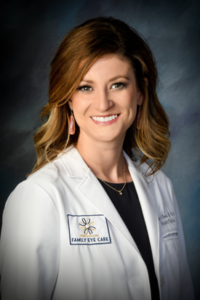

When the eyes are not aligned, the visual system works constantly to compensate for the misalignment, overstimulating the trigeminal nerve. This can cause eye strain, dry eyes, headaches, neck pain and other symptoms known collectively as trigeminal dysphoria. A lifestyle questionnaire asks patients about these symptoms, and the neurolens device can detect the degree of trigeminal dysphoria.
“The volume was less but the time was more impactful,” she says. “We have the opportunity to address patients’ medical concerns. Problems like headaches and eye fatigue are increasing. In fact, solutions for these issues are more in demand with the continuous visual risks of desktop and device usage.”
CHALLENGES WITH MORE SCREEN TIME
Dr. Munson has been using the neurolens Measurement Device and prescribing neurolenses for her patients for over two years. Yet its value has increased with the demands of work-at-home and learn-at-home lifestyles.
“A typical patient might be a working mother, with three children in three different age groups. All of them are on virtual devices more often, and the mother now has to be even more effective, balancing all of those schedules: attending to her own work performance, overseeing the kids’ schoolwork and caring for the home,” Dr. Munson says. Patients like this are facing demands to be “super functional.”
But those kinds of visual demands carry their own challenges. Dr. Munson says that she’s seeing more patients with ocular surface disease symptoms and symptoms of trigeminal dysphoria, such as stiff shoulders and necks and persistent headaches.
“Neurolens has helped us get ahead of some of these issues and even prevent the symptoms from happening, especially in our students,” she says.
SUCCESS REMAINS EXCITING
Even after two years of prescribing neurolenses for patients, Dr. Munson says the excitement is still evident. “Neurolens is a vital technology that I expect to maintain its glamor. It’s so fulfilling to see the gratitude from patients and confirm that we resolved these painful symptoms for them,” she says. She encourages eye care providers who may feel like some of the spark of patient care is dulled to be reinvigorated with this technology.
“Sixty-five percent of patients are symptomatic and in need of this technology from their providers. These lenses are therapeutic; in addition to the clarity of vision, they help also with the quality of life,” she says. “Optometric physicians own the clear and comfortable vision space and thanks to this technology are more than ready to deliver root cause solutions.”
From a practice management standpoint, this technology fills a missing link for the practice who desires to be less dependent on third party reimbursement. Patients can utilize their third party frame allowance and are willing to forego the lens benefit for an out-of-pocket transaction. They consistently perceive the value as a “pain savings” to allow their work life balance to be improved. “I hear patients say, ‘I have my life back’ when they experience days without headaches and pain.”
THE HUB TO SPECIALTY SERVICES
Indeed, patients who benefit from neurolenses are similar to those who suffer from dry eye in that the symptoms are often silent, chronic and progressive. Patients often are not aware that their eye provider will have any solutions for them. Patients don’t think to bring it up. That’s why it’s essential that doctors do.
A practice that wants to advance its reputation and service in dry eye and OSD or even vision performance really benefits from this technology. It’s the hub to help you go in any and all directions,” Dr. Munson says. Dr. Munson understands this well. Fort Collins Family Eye Care has three business units: preventive care, the Vision Performance Center of Fort Collins, and the EyeSpa, and neurolenses play a role in each of them.
“Prevention is the best form of treatment and many practices will survive and thrive during tough economic times with this technology. I hope, as many of my colleagues do, to leave a legacy of great care and neurolens absolutely supports that.”



